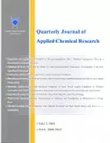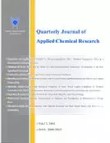فهرست مطالب

Journal of Applied Chemical Research
Volume:17 Issue: 2, Spring 2023
- تاریخ انتشار: 1402/05/14
- تعداد عناوین: 6
-
-
Pages 8-25The requirement for abiding by strict environmental protection regulations has caused many researchers during the past decades to go after using green and cheap compounds available from renewable sources like plant metabolites (bioactive compounds). Improving the corrosion prevention effect of various plant extracts is of utmost importance in this regard, for which a novel nanoemulsion-based strategy is proposed in the present paper. The corrosion inhibitors that participated in this study included Amaranthus, Althermanthea, and Cionura erecta (L.) Griseb, which was investigated against mild steel in 0.5 mol·L-1 HCl media. The presented data were obtained via electrochemical techniques (EIS andpolarization)and surface analyses (SEM). The researchers also used Dynamic light scattering to evaluate the particles’ sizes in nanoemulsion solutions. Nanoemulsions indicated hydrodynamic diameter below 500 nm, meanwhile having narrow particle size distribution.Findings presented that 100 mg/L of Amaranthus extract nanoemulsion resulted in an inhibition efficiency of 91%, denoting that a slight amount of Amaranthus inhibitor extract could produce greater efficiency. The SEM analysis results were decisive in proving that the absorption of Amaranthus molecules on the surface of metal decreased its dissolution rate substantially, producing a smooth and clean surface. One primary reason for the effective adsorption of extracts on metal surfaces via chelation with iron atoms refers to the presence of an abundant number of electron donor Oxygen- based atoms in the molecules of different aerial parts of the extracts. Further description for the extract inhibitory mechanism is the physical adsorption of the section on the surface layer of metal followed by the Langmuir adsorption isotherm. The nanoemulsion Amaranthus extract in this process absorbs approx. -24.7 kJ·mol-1 of free energy. the cytotoxicity test through MTT assay on A172 and SHSY5Y cell lines was used, revealing the therapeutic impact on initiating cytotoxic response in neural cell lines, and anticancer activity.Keywords: Inhibitor, Green corrosion, Cell lines, anticancer, Nanoemulsion, Herbal plants.
-
Performance Investigation of the Membrane PEEK/PVA Modified with ZnO Nanoparticle for CO2 SeparationPages 26-40The characterization of morphological, particle size, mechanical, and thermal on the impactof membrane Polyetheretherketon/Polyvinylalcohol (PEEK/PVA) composite was modified with zinc oxide nanoparticles for Permeability and Selectivity of CO2 properties. Separation process was done at high pressures since the selectivity of CO2 boosted from 94.0 at 1 bar with increasing feed pressure. Also, the permeability of CO2 for membrane PEEK/PVA/ZnO nanoparticle modified with PEEK/PVA composite was performed. The increase in CO2 permeability to the membrane PEEK/PVA from 26.4 to 82.6 occurred upon modifying the surface area of the membrane PEEK/PVA/m-ZnONPs (1.0 wt%, 2.0 wt%, and 3.0 wt%), and increasing the percentage of this additive in the polymer matrix. The increase was due to the presence of cavities developed in the process of surface modification, and the increased of free volume and solubility of CO2 inside the polymer membrane.Keywords: CO2 gas, Membrane, permeability, Selectivity, Separation.
-
Pages 41-60
The applicability of Albizia Stem Bark Lebbeck Modified by Fe2 (MoO4)3 nanocomposite synthesis for removing Rhodamine B dye from aqueous solutions has been reported. Identical techniques including BET, IR, XRD, EDX, and SEM have been utilized to characterize this novel material. Also, the impacts of variables including initial Rhodamine B dye concentration (X1), pH (X2), adsorbent dosage (X3), and Sonication time (X4) came under scrutiny using central composite design (CCD) under response surface methodology (RSM).The values of 10 mg L-1, 0.025g, 6.0, 5.0 min were considered as the ideal values for Rhodamine B dye concentration, adsorbent mass, pH value, and contact time respectively. The adsorption equilibrium and kinetic data were fitted with the Langmuir isotherm model and pseudo-second-order kinetics (R2: 0.999) with maximum adsorption capacity (qmax: 98.0 mgg-1) respectively. Thermodynamic parameters (R2: 0.998, ΔG°: -95.58 kJ mol-1, ΔH°: -29.24 kJ mol-1, ΔS°: -131.49 kJ mol-1 K-1) also indicated Rhodamine B dye adsorption is feasible, spontaneous and exothermic. The overall results confirmed that Albizia Stem Bark Lebbeck Modified by Fe2 (MoO4)3 nanocomposite could be a promising adsorbent material for Rhodamine B dye removal from aqueous solutions.
Keywords: Rhodamine B (RhB) dye, Adsorption, Isotherms, Central Composite Design (CCD), Response Surface Methodology (RSM) -
Pages 61-81
The applicability of CM-β-CD-Fe3O4NPs synthesis for the removal of Aluminum ion from wastewater was studied. The active sites and morphology structure of CM-β-CD-Fe3O4NPs synthesis were analyzed using BET, FT-IR, XRD, SEM, and XPS respectively. The effect of independent variables namely pH, adsorbent dosage, contact time, Al (III) ion concentration in solution, were investigated through batch experiments, and to be 7, 50 mg L-1, 0.1 g and 90 min for the adsorption of Al (III) ion onto CM-β-CD-Fe3O4NPs sorbent were found respectively. The adsorbed Al (III) ion onto the CM-β-CD-Fe3O4NPs showed excellent fitting to the pseudo-first-order adsorption kinetic with a correlation coefficient value of 0.999.Meanwhile, the experimental equilibrium data were fitted to the conventional isotherm models accordingly. Freundlich isotherm has good applicability for the experimental data with a maximum adsorption capacity (qmax) of 35.88 mgg-1 for Al (III) ion onto CM-β-CDFe3O4NPs. The overall results confirmed that CM-β-CD-Fe3O4NPs could be a promising adsorbent material for Al (III) ion removal from wastewater treatment.
Keywords: Aluminum ion, Adsorption capacity, CM-β-CD-Fe3O4NPs, kinetic, wastewater -
Pages 82-95In this study, Mesalazine modified carbon paste electrode (MESA-CPE) was developed and utilized to investigate the electrochemical behavior and determination of amlodipine (AML).The electroanalytical responses were evaluated by cyclic voltammetry, chronoamperometry and differential pulse voltammetry. The MESA/CPE showed good electrocatalytic activity with respect to the electrooxidation of AML with an over potential of 200 mV lower than that of the bare CPE. The sensor showed two linear dynamic ranges from 1.0 to 20.0 µM and 20.0 to 100.0 µM with a detection limit of 0.4 µM (S/N = 5). The MESA-CPE was applied for the determination of AML in some pharmaceutical formulations.Keywords: AMLODIPINE, Mesalazine, Carbon paste electrode, Voltammetry, Electrocatalytic activity
-
Pages 96-108
In this work, Fe2O3 nanoparticles were used to increase the cement strength and to increase the corrosion resistance of the rebar inside it. For this, the nanoparticles were added to the cement mortar with one percent of the cement weight. According to the ASTMC109 standard, bending and compressive strengths of 7 days and 28 days were obtained and compared with the control sample. The results showed that by adding this nanoparticle to cement, the bending and compressive strengths of cement mortar have been increased. To investigate the corrosion resistance of the rebar inside the cement mortar, polarization and Electrochemical Impedance Spectroscopy (EIS)tests in 3.5% sodium chloride solution were measured and evaluated. The results of the polarization test showed that by adding this nanoparticle to cement mortar, the corrosion current decreases and the corrosion potential increases. EIS measurements confirmed the increased corrosion resistance of rebar inside the cement. Finally, the reason for increasing the corrosion resistance is investigated by equivalent circuit simulation.
Keywords: Nano particle, Fe2O3, Cement, impedance, EIS, Polarization.


